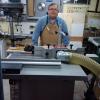Since I started woodworking, I noticed that most power-tool equipment (Planers, Jointers, TS, BS, etc..), planes, chisels, etc. are designed to make straight/plane cuts.I came across a SMC forum post a while back in which the SMC member used the angle grinder (and Sam Maloof's video tutorial) to build a rocking chair. What struck me as unconventional was that he had used the angle grinder to shape the chair.
Shaped furniture pieces often feature elegant curves as part of component design. With the current tools I have (TS, BS, Jointer, Planer), I can't achieve the sort of sculpted form that shaping wood produces. What is the proper technique to build, say a rocking chair, from start to finish?
I'm a beginner woodworker so I'd be greatful if you could direct me to the right resources!
[Sam Maloof Documentary]
https://www.youtube.com/watch?v=1oZSkD7WoJ4




 Reply With Quote
Reply With Quote

 .
.